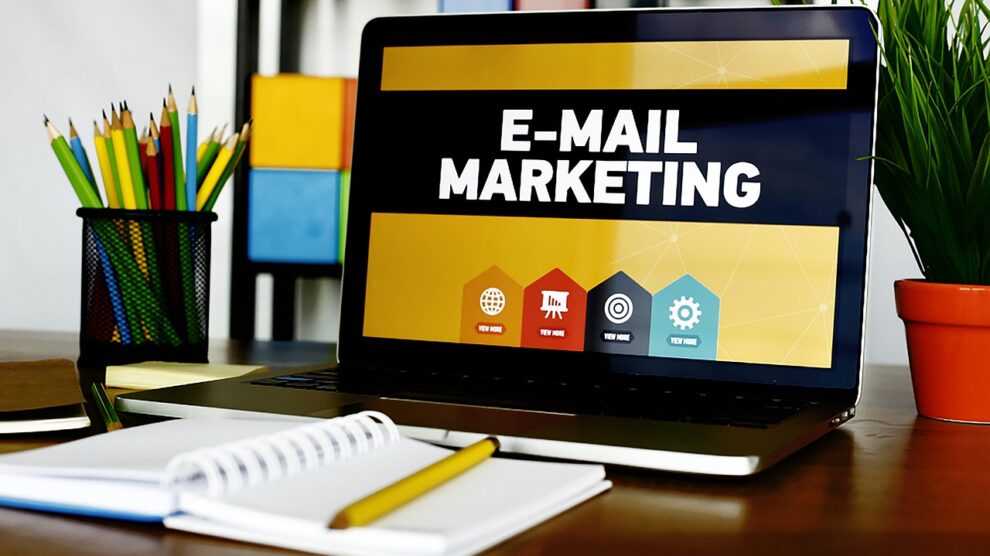Email marketing is a tool that lets business leaders talk directly to customers. Think of it as sending letters, but faster and smarter. Even with all the new ways to communicate today, email remains very powerful.
It’s like having a special key that opens doors right into people’s inboxes.
It might surprise you, but 42% of small businesses find their way to success through emails. Emails can be personal, like chatting with a friend who wants to buy what you sell without spending too much money on ads.
And though we see lots of tweets and posts daily, emails are still champions at getting messages across in business.
Smart bosses use email because they can make sure the right people see their message at the right time, making more money come back for every dollar spent. To do this well, they grow a list of people who care about what they offer.
Sending exciting and fun emails keeps these folks interested until they’re ready to buy.
Adding cool things like names and interests makes each email feel less robot-like and more friendly – imagine getting an invite just for you! Plus, computers can even help send these special notes while measuring how good a job it’s doing; fancy stuff like using phones or adding short videos may be extra important soon.
We’ll chat about making ace email lists, writing great messages that make readers click “buy,” using tech smarts for easier work days, and checking if our plan worked—all essential tricks for anyone wanting their business inbox filled not just with emails but also with opportunities.
Let’s unlock those strategies together!
Key Takeaways
- Email marketing lets business owners talk straight to people interested in their products, with 42% of small businesses finding it effective.
- Building a good email list is key, using tools like finders and keeping the list fresh with eager customers.
- Strong, punchy words and personal stories grab attention in emails. One or two pictures can help but too many slow things down.
- Using automation saves time by sending tailored messages when people sign up or buy something. Personalizing these messages makes them more special.
- To get better at email marketing, look at open rates and what people do after getting the email. Changing your plan based on what you learn helps a lot.
Understanding the Power of Email Marketing
From a broad view to a tight focus, email marketing is a super tool entrepreneurs can’t ignore. It’s like having a magic wand to reach directly into customers’ inboxes with just the right words and offers.
This power lets businesses talk straight to people who are interested in what they have to say or sell.
Think of it as being at a huge party and knowing exactly who wants to chat about your amazing new product—and then getting those conversations rolling without any awkward small talk! Email marketing makes this possible because you can send messages that matter to each person.
You’re not shouting over the crowd; you’re whispering into someone’s ear, making them feel special with targeted and personalized messaging. That’s how connections grow stronger and sales numbers go up.
Using email finders, smart bosses make sure their emails land where they should – making lists packed with folks eager for news on their latest brainwaves or bargains. The secret sauce? A mix of great timing, messages that catch the eyes, and tools like LinkedIn email finders that help keep contact lists fresh and ready for action!
Building a High-Quality Email List
After exploring the power of email marketing, it’s clear that a high-quality email list is your next big step. A good list lets you talk directly to people who care about your business.
- Start with a plan: Before you look for emails, decide what kind of customers you want. Think about who will love your product or service.
- Use email finders: Tools that find emails can help you grow your list fast. Make sure they are the right fit for your audience.
- Give something valuable: Offer a coupon or useful information in exchange for an email address. People like getting gifts and will more likely sign up.
- Make it easy to join: Put sign-up links everywhere possible – on your website, social media, and at the end of emails.
- Always get permission: Never add someone to your list without their okay. It builds trust and follows the rules.
- Keep it fresh: Regularly check your list for old or wrong emails and take them out.
- Stay relevant: Send emails that matter to the people on your list so they keep reading.
- Talk like a friend: Write as if you’re chatting with someone you know well. This makes people feel special and listened to.
Crafting Compelling Email Content
Crafting compelling email content can make your message stand out in a crowded inbox. Think about what grabs your attention when you open an email; it’s often a catchy subject line or that first sentence that hooks you in.
That’s why it’s great to start with strong words and clear ideas. Use stories, jokes, or questions to connect with people right away.
Keep sentences short and punchy – they’re easier to read and more likely to keep the reader moving down the page. And don’t forget the pictures! A good image can say a lot and make your emails more fun to look at.
But remember, too many pictures might slow down how fast the email opens, so just stick with one or two that help tell your story.
Use language that speaks directly to readers’ needs and wants—like how your service saves time or makes life easier. Always be honest about what you offer and why it matters. This makes people trust you more.
People will think you know a lot.
Keywords like “email finders for email list” are handy tools too! These can help entrepreneurs grow their list of contacts quickly but make sure the quality stays high—it’s all about getting the right people hooked on what you have to say.
Automation and Personalization
Automation in email marketing simplifies the process of sending tailored messages to your audience at scale. By utilizing automation tools, you can schedule emails based on triggers like sign-ups or purchases, saving time and ensuring consistent communication.
This not only streamlines your workflow but also allows for personalized content delivery without manual effort.
Personalization is key to creating meaningful connections with your audience. Tailoring emails to individual preferences or behaviors can significantly increase engagement and conversion rates.
Utilize data-driven insights to personalize subject lines, content, and product recommendations, showing your audience that you understand their needs and interests. Implementing automation alongside personalization empowers entrepreneurs to deliver relevant and timely content efficiently.
By leveraging email automation and personalization strategies, entrepreneurs can create targeted campaigns that resonate with their audience on a deeper level while maximizing efficiency.
This combination of automated workflows and tailored messaging ensures that each interaction feels personalized, ultimately driving higher engagement and conversions.
These strategies enable founders, C-Suite business leaders, consultants, developers, marketers, and product teams to effectively reach their target audience with engaging content tailored to individual preferences.
Measuring Success and Iterating
After setting up automated personalized emails, it’s time to measure the impact and make necessary improvements. Here are the key steps for measuring success and iterating:
- Analyze Open and Click Rates: Look at how many people opened the email and interacted with its content. Understand which subject lines and content types resonate best with your audience.
- Track Conversion Rates: Measure how many recipients took action after engaging with your email. This could include making a purchase, signing up for an event, or downloading a resource.
- Monitor Unsubscribes and Complaints: Keep an eye on unsubscribe rates and feedback from recipients who mark your emails as spam. Use this data to refine your content strategy.
- Assess A/B Testing Results: Continuously test different elements of your emails, such as subject lines, CTAs, or visuals, to identify what drives better engagement and conversions.
- Utilize Feedback Loops: Gather insights from customer feedback and use them to adjust your email marketing strategies for better alignment with customer needs and preferences.
- Data-Driven Decision-Making: Use data analytics tools to gain insights into subscriber behavior, preferences, and engagement patterns that inform future campaign optimizations.
Conclusion
In conclusion, email marketing remains a potent tool for entrepreneurs. The strategies outlined in this article are practical and efficient for businesses of all sizes. Implementing these approaches can lead to significant improvements in reaching and engaging target audiences.
For further reading, consider exploring resources on effective email marketing tactics. Remember, taking action based on these simple strategies can yield substantial results for your business.
FAQs
1. Is email marketing still a good choice for entrepreneurs?
Absolutely! Email marketing remains a powerful tool for entrepreneurs because it’s super cost-effective and fantastic at building relationships with customers through targeted messaging.
2. Why does email matter when there are so many social media platforms?
Well — social media is cool and all — but email marketing lets you send personal notes right into someone’s inbox. It means you can make each message feel like it’s just for them!
3. What makes email marketing stand out as a smart strategy?
Here’s the secret sauce: it’s good at keeping your audience interested over time. With emails tailored to their likes and needs using personalization tricks; folks are more likely to stay engaged.
4. Can simple strategies in email marketing get results?
You bet! Even straightforward tactics can help fire up conversations between businesses and their customers – making sure no one misses out on something they might love or need.





